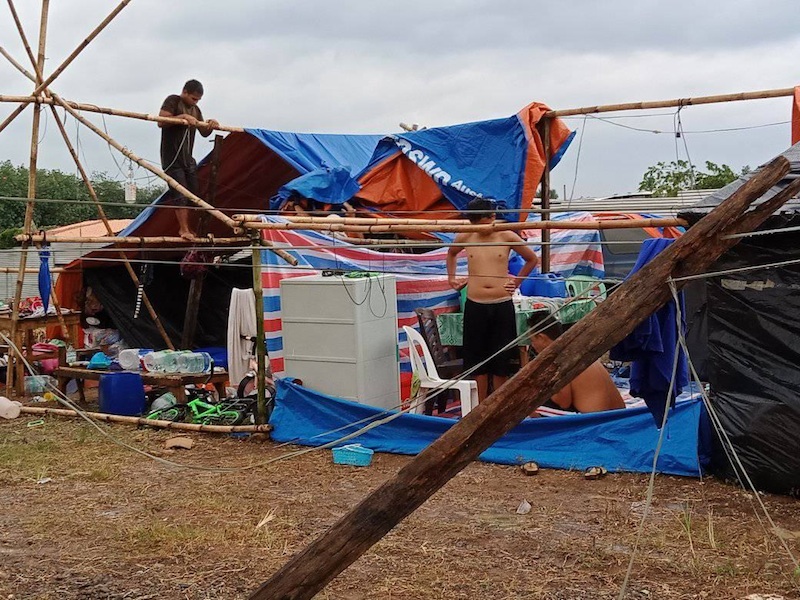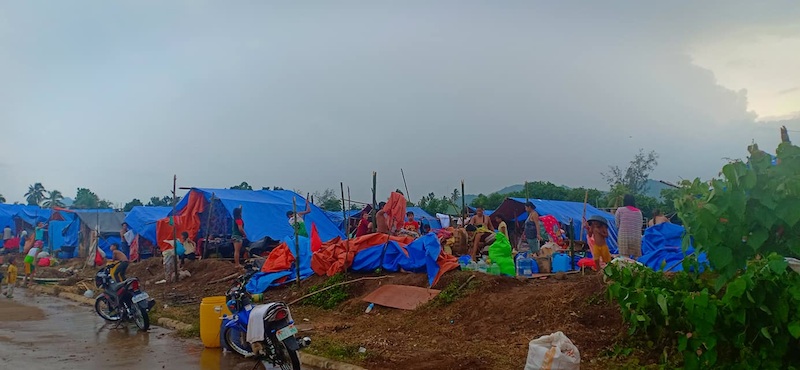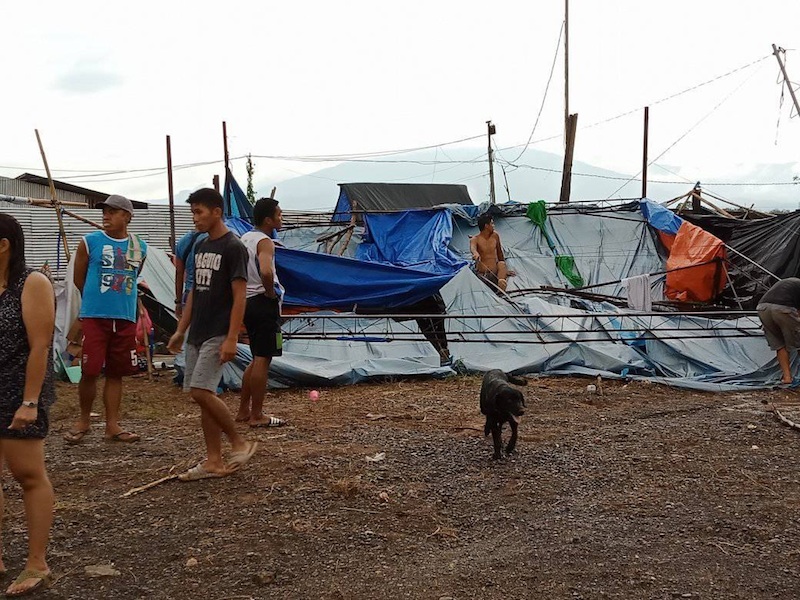DAVAO CITY (MindaNews / 13 November) – Bakwits once, twice. How many times more?
A number of residents who evacuated to the town center of Makilala in North Cotabato following quake-induced landslides in their hinterland villages on October 29 and 31 had to be relocated from their evacuation camps late Monday afternoon when their tents collapsed or were destroyed by a hailstorm. But their stay there is only temporary: until they get to fix their tents in their designated evacuation camps.
Some stayed on in their evacuation centers but spent late afternoon until early Tuesday morning fixing their tents so they could sleep.
 After the earthquakes, the hailstorm. Evacuees at the Makilala Institute of Science and Technology evacuation camp in Makilala, North Cotabato fix their tents destroyed by a hailstorm on November 11, 2019. Photo courtesy of MONALYN ALVAREZ SEMERA
After the earthquakes, the hailstorm. Evacuees at the Makilala Institute of Science and Technology evacuation camp in Makilala, North Cotabato fix their tents destroyed by a hailstorm on November 11, 2019. Photo courtesy of MONALYN ALVAREZ SEMERA
“Lord, unsa nmn ni? Linog tapos bagyo na sad karun ug niulan ug ice. Grabe najud ni” (Lord, what is this? Earthquake then storm then it rained ice), Monalyn Alvarez Semera of Barangay Buhay posted on her Facebook page at 4:16 p.m. on Monday, November 11. Fourteen minutes later, she posted photographs of the hailstorm’s aftermath in the evacuation camp at the Makilala Institute of Science and Technology (MIST) in Barangay Concepcion: tents toppled by the winds, men and women collecting items that got soaked in the heavy downpour and rain of ice. Some could be seen fixing the laminated sack on the bamboo or aluminum frame that would serve as their family’s roof.
Darkness had set in, even if it was barely 5 p.m.
Acting North Cotabato Vice Governor Shirlyn Macasarte Villanueva announced through her Facebook post late afternoon of November 11 that they were preparing to “relocate our evacuees affected by the storm.”
 Tents at Santos Land evacuation camp in Makilala, North Cotabato after the hailstorm on Monday, 11 November 2019. Photo courtesy of Shirlyn Macasarte Villanueva
Tents at Santos Land evacuation camp in Makilala, North Cotabato after the hailstorm on Monday, 11 November 2019. Photo courtesy of Shirlyn Macasarte Villanueva
She cited the affected evacuation camps as Santos Land, MIST, Poblacion elementary school and Saguing evacuation centers.Evacuees in Santos Land evacuation camp were transferred to the Makilala National High School gym.
Myrna Linao, a Bagobo Tagabawa and the Indigenous Peoples Mandatory Representative in Barangay Buhay told MindaNews in a telephone interview Tuesday afternoon that the tent materials that were destroyed by the storm were immediately replaced. Linao said they hope folding beds could be provided particularly for the children, the pregnant and the elderly as sleeping on the ground with laminated sack as sheet is very unhealthy, especially when it rains.
There are 135 Lumad families who have sought refuge there. Of this number, Linao said 98 are senior citizens, 11 are pregnant and 40 are lactating mothers
Palawan, representative of the 164 Moro families in the camp had told MindaNews on November 8 that in the early part of their stay, when it rained, they had to stand while trying to get some sleep because the ground – and the laminated sacks – were wet.
 Hailstorm aftermath at the Makilala Institute of Science and Technology evacuation camp in Barangay Concepcion, Makilala, North Cotabato which hosts predominantly Moro and LUmad familities. Photo courtesy of MONALYN ALVAREZ SEMERA
Hailstorm aftermath at the Makilala Institute of Science and Technology evacuation camp in Barangay Concepcion, Makilala, North Cotabato which hosts predominantly Moro and LUmad familities. Photo courtesy of MONALYN ALVAREZ SEMERA
Evacuees in schools prefer to pitch tents in school grounds instead of classrooms or nearby gyms, afraid another powerful quake will happen.
Four quakes above Magnitude 6 struck this town and neighboring areas between October 16 and 31: 6.3 on October 16, 6.6 and 6.1 on October 29 and 6.5 on October 31.
Barangay Buhay is one of four villages declared “no-build zone” out of 38 villages in Makilala.
Sheryl Orbita, Makilala Municipal Administrator, told MindaNews last week that the local government is looking for relocation for residents of the villages declared ‘no build zones’ – barangays Bato, Buhay, Cabilao and Luayon.
 Hailstorm aftermath at the Makilala Institute of Science and Technology evacuation camp in Barangay Concepcion, Makilala, North Cotabato which hosts predominantly Moro and LUmad familities. Photo courtesy of MONALYN ALVAREZ SEMERA
Hailstorm aftermath at the Makilala Institute of Science and Technology evacuation camp in Barangay Concepcion, Makilala, North Cotabato which hosts predominantly Moro and LUmad familities. Photo courtesy of MONALYN ALVAREZ SEMERA
She said they have several options to choose from but they will have these checked by the Philippine Institute of Volcanology and Seismology (Phivolcs) and the Mines and Geo-sciences Bureau.
In the areas declared as “no-build zones,” Orbita said Phivolcs informed them farming can still be done at daytime but not when it rains. Living there, however, will not be allowed, she said.
Linao on November 8 said they hope government will relocate them immediately so they can settle down and begin a new life. (Carolyn O. Arguillas / MindaNews)
